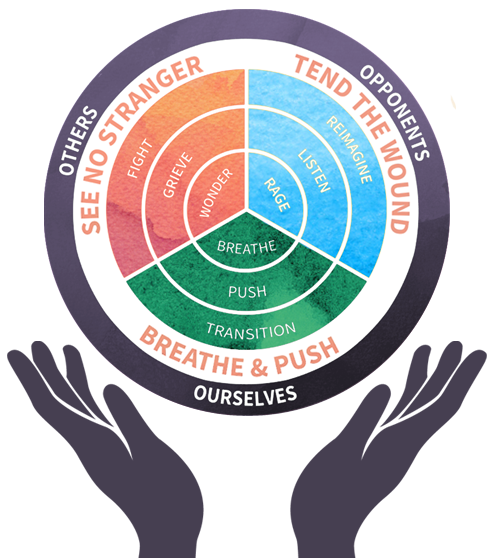10: Joy

“In joy, we see even darkness with new eyes. Joy returns us to everything that is good and beautiful and worth fighting for. I was not alone. I was one in millions. I was part of a movement, one in a constellation. I had to shine my light in my specific slice of sky. I could do that.”
“Joy is possible even amid great labors—the labor of dying, the labor of birthing, and the labors between. We cannot force it. But when we create moments to breathe between labor pains, and surrender our senses to the present moment, notice the colors and light and feeling of being alive, here, together, joy comes more easily. In the face of horrors visited upon our world daily, in the struggle to protect our loved ones, choosing to let in joy is a revolutionary act. It gives us energy for the long labor.”
—Valarie Kaur, See No Stranger, Chapter 10
Understanding Joy
Joy is the core practice that sustains all others. To let in joy is to give our senses over to what is beautiful, delightful, pleasurable, or wondrous in the present moment.
Joy is the gift of love. Joy returns us to everything good and beautiful and worth fighting for. It gives us energy for the long labor.
- What brings you joy? Choose one thing that is simple and accessible. A person, a place, or an activity that you could go to right now if you wanted to.
- Notice what it is about this thing that brings you joy. See it, touch it, taste it. Remember how it felt when you were fully in it. The sensation could be very strong. Or just a slight feeling. Place more attention on it. Let yourself enjoy it.
- What does joy feel like in your body? Notice where you feel sensation, ease, and tingling. Place your attention there and notice what happens. Go back and forth between your source of joy and the sensations in your body.
- Notice any blocks to letting yourself feel this joy. Feelings of guilt or shame? Stories about what you deserve? Call upon your deepest wisdom to speak to yourself as you would your own beloved child or best friend. What do you hear?
- What do you need to protect this joy every day? Joy is your birthright. The deepest wisdom within you knows what you need to do. Listen.
- Why is joy a necessary practice of revolutionary love?
- What is gained—for others, opponents, and ourselves—when we practice, protect, and cultivate our joy?
- In what ways is joy an act of moral resistance and reimagining?
- Make joy a daily practice. Notice and explore what makes you joyful. Is it music, art, creativity, and movement? Is it time spent with friends, community, children? What brings you pleasure? What enlivens your imagination? What gives you a felt-sense of rising energy? What people, places, and practices remind you of what is good and beautiful and worth fighting for? Protect joy every day. Help others find it and protect it too.
- Notice how joy feels in your body. Perhaps it is a lightness in your limbs, a relaxing of your jaw, and a sense of calm and ease. If joy is hard to find, start with gratitude for small things: a hot cup of tea, a warm exchange, the voice of a friend, a tree out the window. Notice what even small moments of joy feel like in your body.
- Keep a joy or gratitude journal to note the things that made you joyful each day. Work to protect your joy, especially when things are hard. Share your joy in community.
- Explore how joy is a practice of moral resistance and reimagining. Movement builders have long used art, dance, movement, and song to ground their work in joy and community. Some present day examples include the work of Resistance Revival Chorus, Activist Songbook, Girl Trek, Favianna Rodriguez, Julio Salgado, and many others. For deep exploration into joy and pleasure, check out adrienne maree brown and her book Pleasure Activism.
- Turn to community and loved ones when you need support. These actions, too, can be joyful. adrienne maree brown describes joy as feeling her own aliveness, purpose, and agency, the ability to make choices and seek connection even in the difficult moments.
- Explore the deeper meaning of joy. The Sikh tradition invites us into a state of Chardi Kala — ever-rising spirits, even in darkness; ever-rising joy even in the labor. Even when we feel hopeless, we can still let in joy in the present moment. Laboring for a more just and beautiful world with joy can be the meaning of life.
- Revolutionary love is a lifelong practice. In your wisdom journal, imagine each day as a lifetime, and each night reflect upon these questions from Valarie Kaur:
- What was the hardest part in this lifetime? Notice where you sense that hardship in your body. Now how did you get through it? We somehow managed to make it to the end of this day, the end of this lifetime.
- What was the most joyful part of this lifetime? Every day and every lifetime, no matter how hard, contains moments of joy. Notice what made it joyful. Sense what joy feels like in your body. What did you learn from the joy? How can you bring more of it in?
- What are you most grateful for in this lifetime? Every day and every lifetime offers a new reason for gratitude. Sense that gratitude in your body.
- Now are you ready to let go of this lifetime? Are you ready to think of the work you have done today and know that it is enough? You are enough.

